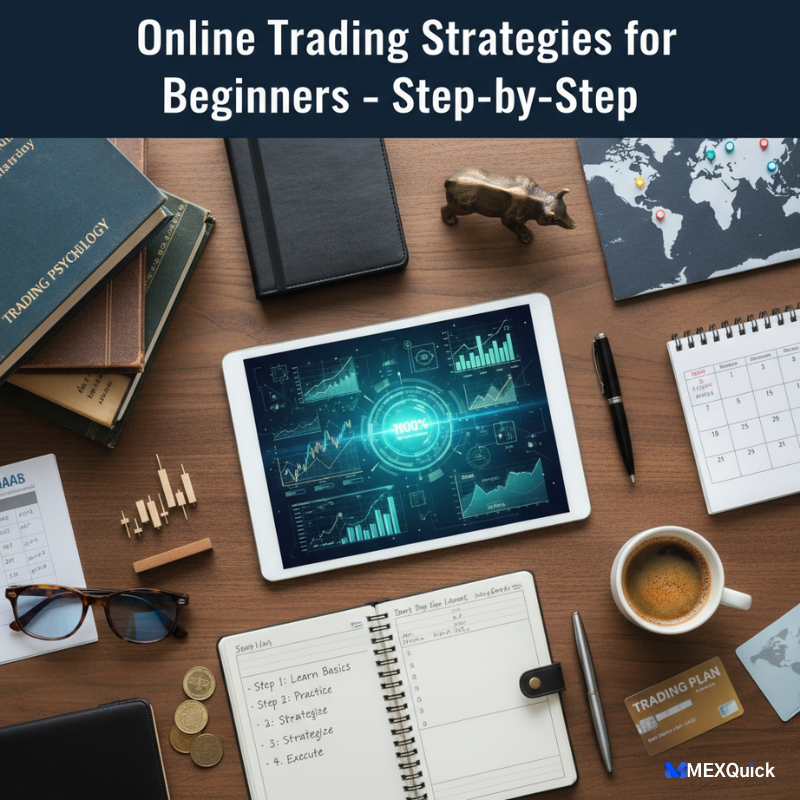
When I first started trading, I spent months jumping from one complex strategy to another. I tried to predict earnings reports, day-trade volatile stocks, and even dabbled in forex. The result? Confusion, stress, and inconsistent results. I was missing what truly matters: a simple, structured online trading strategy that I could actually execute.
The secret isn’t finding a “magic bullet.” It’s about building a disciplined process that you can follow consistently. A solid online trading strategy is your roadmap in a chaotic market. It tells you when to enter, when to exit, and—most importantly—how to protect your capital.
This guide is the one I wish I had. I’m going to give you a clear, step-by-step trading blueprint for building your first effective strategy. We’ll focus on foundational beginner trading tips and a practical approach to how to trade online without the overwhelm. Let’s build your foundation for long-term success.
The Foundation: Building Blocks of Any Trading Strategy
Before we dive into specific tactics, every successful online trading strategy rests on three non-negotiable pillars. Ignore these, and you’re not investing—you’re gambling.
1. Risk Management: Your Survival Kit
This is the most critical component. Your primary goal is to preserve your capital.
-
The 1% Rule: Never risk more than 1% of your total trading capital on a single trade. If you have a $5,000 account, your maximum loss per trade should be $50.
-
Use Stop-Losses Religiously: A stop-loss is a pre-set order that automatically sells your asset if it hits a certain price, capping your loss. This is non-negotiable.
-
Why it Matters: Even the best strategies have losing streaks. Proper risk management ensures a string of losses doesn’t wipe you out, keeping you in the game.
2. Trading Plan: Your Business Plan
A trading plan is a written set of rules that governs every decision you make. It removes emotion from the equation.
-
Your plan must define: Your chosen market (e.g., large-cap US stocks), your time commitment (e.g., 1 hour per day), your criteria for entering a trade, and your rules for exiting (both for profit and loss).
3. Trader’s Mindset: The Psychological Edge
The market is a test of patience and discipline.
-
Embrace Losses: Losing trades are a cost of doing business, not a personal failure. Even professional traders are often only right 50-60% of the time.
-
Avoid FOMO (Fear Of Missing Out): Chasing a stock that’s already skyrocketed is a recipe for buying at the peak. There will always be another opportunity.
Your First Two Beginner-Friendly Trading Strategies
Here are two simple, time-tested strategies perfect for learning how to trade online. Pick one to master first.
Strategy 1: Trend Following
This strategy is based on the old adage, “The trend is your friend.” You’re buying assets that are already moving in a strong direction (up or down) and riding the momentum.
-
The Concept: Identify an established upward trend and buy pullbacks within that trend.
-
Step-by-Step Trading Example:
-
Identify the Trend: Use a chart with a 50-day and 200-day Simple Moving Average (SMA). If the price is above both, and the 50-day is above the 200-day, an uptrend is confirmed.
-
Wait for a Pullback: Let the price dip slightly towards the 50-day SMA.
-
Enter the Trade: Buy when the price bounces off the 50-day SMA support level.
-
Set Your Stop-Loss: Place your stop-loss just below the most recent swing low or the 200-day SMA.
-
Set Your Take-Profit: Aim for a profit target where the price might meet resistance, or use a risk-reward ratio (e.g., if you risk $1, aim for a $2 profit).
-
Strategy 2: Support & Resistance Trading
This strategy trades on the idea that prices have a “memory” and tend to react at certain key levels.
-
The Concept: Buy near a proven “support” level (where the price has bounced up before) and sell near a “resistance” level (where the price has fallen from before).
-
Step-by-Step Trading Example:
-
Identify Key Levels: Look at a chart and find clear horizontal levels where the price has reversed multiple times.
-
Enter at Support: When the price approaches a proven support level, place a buy limit order just above it.
-
Set Your Stop-Loss: Place your stop-loss just below the support level. If the price breaks down through support, the trade idea is invalidated.
-
Set Your Take-Profit: Your initial profit target is the nearest resistance level.
-
Your Step-by-Step Action Plan to Execute Your First Trade

Theory is useless without action. Follow this step-by-step trading checklist.
-
Education & Paper Trading (1-2 Months):
-
Open a demo account with a reputable broker.
-
Practice one of the two strategies above until you can execute it without hesitation. Your goal is consistency in a simulated environment.
-
-
Define Your Plan (1 Week):
-
Write down your chosen strategy, risk management rules (the 1% rule!), and the markets you will focus on.
-
-
Analysis & Selection (Ongoing):
-
Spend time each day scanning the markets. For Trend Following, look for assets in strong trends. For Support/Resistance, identify assets nearing their key levels.
-
-
Execute & Manage (The Trade):
-
Place the Trade: Enter your buy order and simultaneously place your stop-loss and take-profit orders. This is a key beginner trading tip—it automates your exit strategy.
-
Let It Run: Once the trade is live, do not cancel your stop-loss or take-profit unless your original plan dictated a specific adjustment. Avoid emotional tweaking.
-
-
Review & Refine (Weekly):
-
Keep a trading journal. Record every trade, the reasoning behind it, the outcome, and your emotional state. Review this journal weekly to identify patterns and improve.
-
Conclusion: Your Journey to Confident Trading Starts Here
Developing a profitable online trading strategy is a marathon, not a sprint. It’s built on the boring, disciplined execution of a simple plan, not on exciting, risky gambles. By focusing on risk management, choosing one simple strategy, and following a step-by-step trading process, you separate yourself from the 90% of beginners who fail.
Remember, the goal of your first 50 trades isn’t to get rich. It’s to execute your plan perfectly. The profits will follow the process.
Your Actionable Next Steps:
-
Choose One Strategy: Decide right now—will you start with Trend Following or Support/Resistance? Commit to it.
-
Open a Demo Account: If you haven’t already, do it today. Practice your chosen strategy for a minimum of 20 trades.
-
Draft Your Trading Plan: Use the framework above. Write down your 1% risk rule and your strategy’s entry/exit criteria.
The market isn’t going anywhere. Your mission is to be prepared, disciplined, and patient.
I’d love to hear from you. Which of the two strategies are you most excited to try first? What’s the biggest hurdle you’re facing in building your online trading strategy? Share your thoughts in the comments below—let’s build a community of disciplined traders. If this guide provided a clear path, please share it with someone else who needs it.
